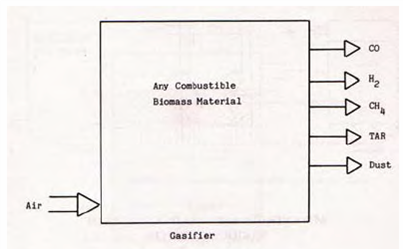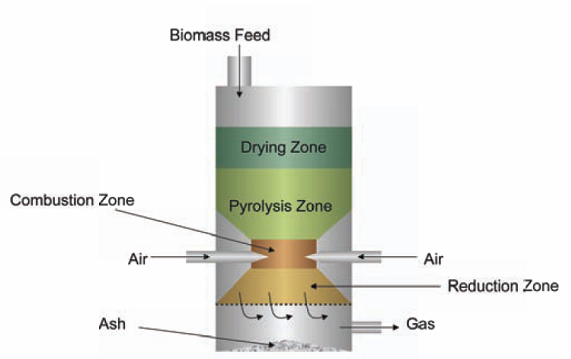Gaseous Biofuels : Thermo-chemical approach
Gasification
Gasification is process of converting biomass resources into gaseous compounds (producer gas or syngas) by supplying less oxygen than is needed for complete combustion of the fuel. The type of gas produced depends upon the process type and operating conditions (Ref: Samy Sadaka, Univ of Arkansas).
asification is a reliable biomass energy based system that has been used for transportation and on farms for many decades. (Ref : Rajwansh i) It has multiple uses viz transportation fuel, for electricity generation, substitute of oil in heating furnaces and production of Methanol. Brazil and Philippines are two countries where large scale manufacturing of gasifiers is carried out.
Technology
Incomplete combustion of biomass at relatively lower temperatures results into a producer gas which is a mix of Hydrogen, Carbon Monoxide and traces of methane. Since air is used as reactive agent, producer gas may have lot of Nitrogen.

(Ref : Rajwansh i)
Syngas : Gasification of the biomass at higher temperatures (1200°C to 1600°C) using steam or Oxygen can result into syn-gas (CO + H2) which can be converted into synthetic fuels by Fischer-Tropsch process into synthetic fuels is possible. However the process is a high-cost operation making it unviable many times.
Any biomass material can undergo gasification making this technology attractive. Eg : Biomass wastes from the food processing industry, agricultural & forestry residues such as straw, firewood, saw dust, rice husks, coconut shell, groundnut shell etc., which can be gasified. (Ref: Kaushik et al. TIFAC). Morphology and composition of biomass is a deciding factor for selection of gasification route using criteria of technical feasibility and economic viability of conversion. Solid biomass such as wood and with low moisture content is suitable for thermochemical process. (Ref : Yadwad et al. 2012 IJERT)
Gasification Reactors
Two main types : Fixed bed and fluidized bed. Typical fixed bed reactors are classified into 3 types depending respective direction of flow of gasification medium and fuel - updraft, downdraft, crossdraft.
Four different processes occur as the biomass fuel makes its way to gasification. Shown here for a typical downdraft gasifier

(Ref: Samy Sadaka, Univ of Arkansas,)
Fluidized bed - (newer) has a bed made of an inert material acting as heat transfer medium. Bed is initially heated and biomass is introduced when the temperature has reached the appropriate level. The bed material transfers heat to the biomass fuel and blows the reactive agent through a distributor plate at a controlled rate. Advantages: flexibility of feed rates, composition, easy control of temperature, but produces lot of dust and tar.
Multiple factors affect gasification such as temperature, pressure and height of the reactor bed; the fluidization velocity; the characteristics of the fuel. Gasifiers should be ideally tailored according to biomass keeping in view density, moisture, dust, tar contents etc.
Applications
- For internal combustion engines. Diesel run duel fuel type of automobiles, particularly low speed vehicles can use gaseous fuel without significant reduction in efficiencies.
- Direct heating (better than solid biofuels for regulated heating)
- Production of captive power - biopower/electricity
- Production of chemicals.
(Potential) uses in Agriculture
On farm generation of producer gas can be used for farm locomotives, small scale electricity generation, irrigation systems. Heat generated by this technology can be used for grain drying, refrigeration.
Challenges in Gasification Technology
(Ref : Rajwansh i, Ref : Yadwad et al. 2012 IJERT )
- Creation of automobile engines specifically for producer gas. Unlike CNG or LPG, producer gas is not suitable for existing petrol engines because of high power derating due to low energy yield per cubic metre gas burned.
- Reliable gas producer which is also economically attractive to the customer.
- Gas needs to be cooled and cleaned to be used in various applications, particularly for internal combustion engines.
- Inadequate fuel/biomass quality. Variation in composition of producer gas.
- Lack of detailed comparison studies of engine efficiencies with and without producer.
- Storage systems for uniform gas quality.
- Gasifiers are expensive at lower scale.
- Research in optimum utilization of biomass residues.
Gasification Techology : Status in India
(Ref : Yadwad et al. 2012 IJERT)
Research : Four ARCs established for gasifier engine research & development at various national institutions. Various capacity gasifier models, spark ignition producer gas engine has been developed by these centres. A Producer Gas Engine (Spark Ignition) has also been developed at the ARC, IIT Bombay with a flexible fuel system. Biomass research centres in NBRI Lucknow, Vishwabharati - Shantiniketan.
Gasifier systems : > 2200. There are about 15 gasifier system manufacturers.
Producer gas engines are manufactured by Cummins India Ltd, Pune. In India, producer gas is used in four-stroke stationary diesel engines on dual-fuel mode with 70% diesel replacement.
